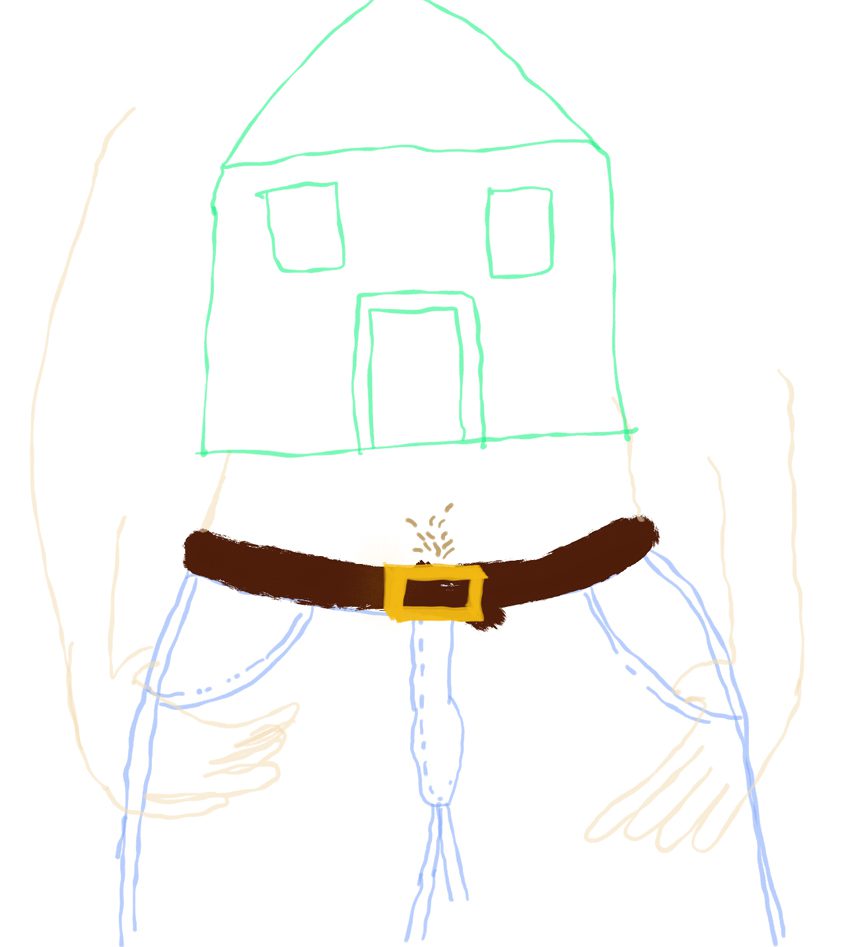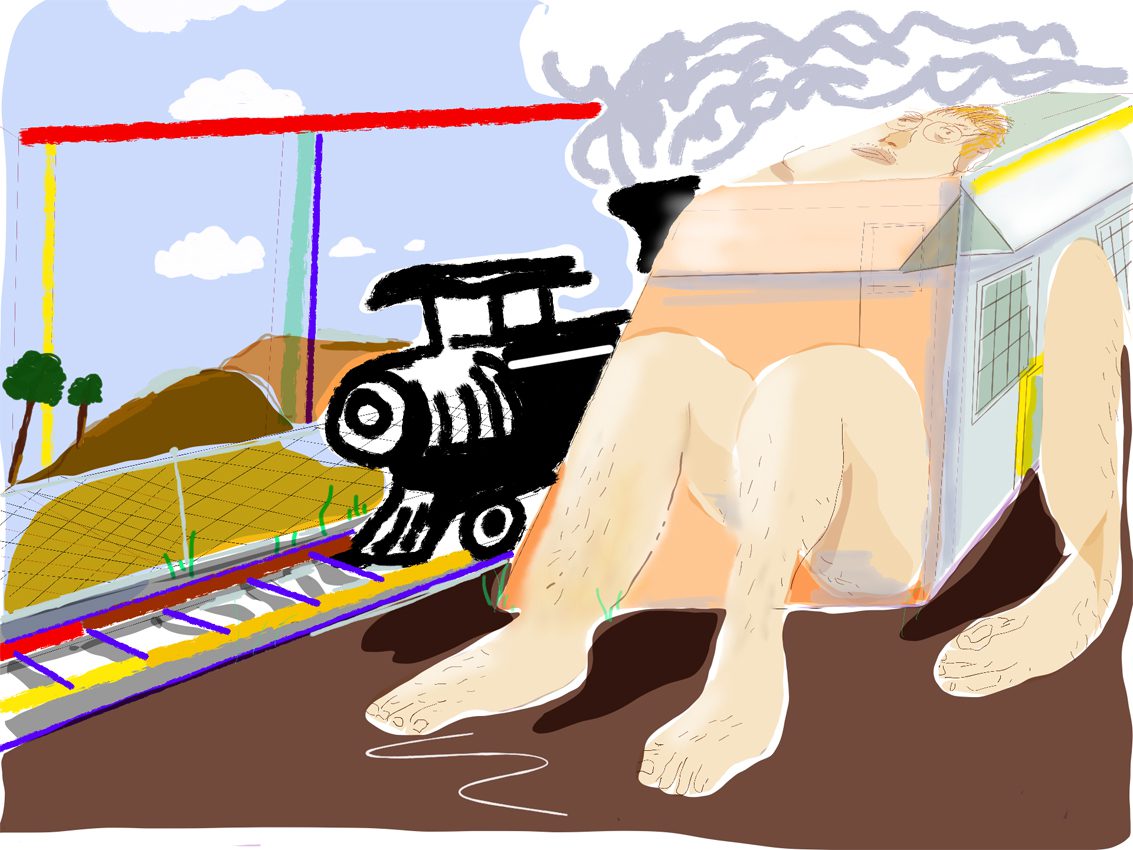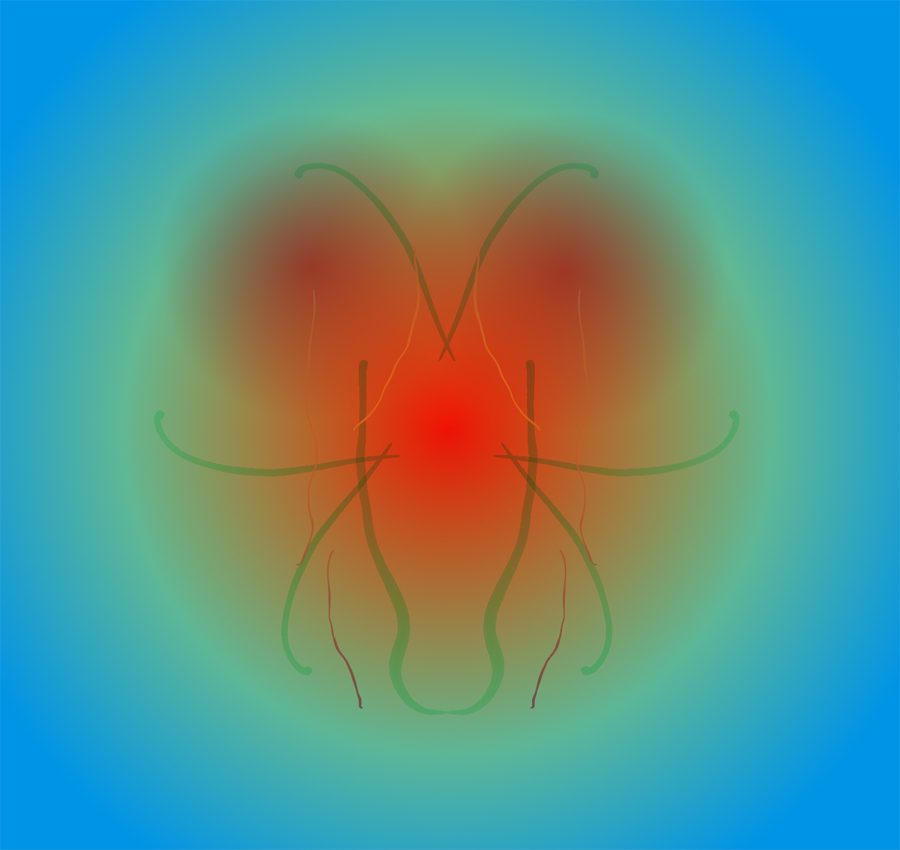My body is electric with desire when I realize I haven’t been held for months. I swipe back and forth on photos of strangers in an eternal quest for that rat-pellet hit of dopamine: a rainbow in the bio; a mention of #t4t; someone, anyone, not holding a dead fish up by the throat. Intellectually, I know that I am trying to fill an emotional need in an unhealthy way. I note this fact and keep swiping. In Time Is the Thing a Body Moves Through, T Fleischmann wonders whether if what we all have in common, the thing that “binds the family of man together,” is the “desire for a top and the lack of a top.” Inside the glassed-in pane of my phone, square avatars of tops want to fill me up. My mind stays in the gutter. At the edges of several queer polycules, I receive leftover dregs of physical and emotional affection when others have extra capacity.
G and I meet not on Tinder, but at the sole coffee shop in the town where I teach. When we find each other, it is with mutual delight and exuberance, recognizing our iterations on queer-coded masculinity in a place not always welcoming of it, as though we are the two houses painted green in an all-gray block. Over a score of Christian contemporary, she asks if I want to come over and get drunk by a campfire in her parents’ backyard, where she has dug a hole behind their looming manse that is silhouetted against the dusk. I do. The shock of recognition: She has Big Top Energy. I feel foolish for spending so much time on apps when she’s been here the whole time, a gender nonconforming butch dyke, in the same tiny town in rural Alabama.
The line between our external gender expression blurs to circularity. We’re both AFAB and masculine-presenting, so we share clothes, even though internally our self-perception marks near-opposite ends of a spectrum: She’s a butch dyke and I’m a trans man. I edge toward manhood as though toward the ledge of a skyscraper. Every now and then I peer over the edge with a rush like vertigo, like a sudden sense of my own mortality. Here’s what the ground looks like, if only I were ready to leap.
When we hang out, G leans against her parents’ hundred-and-fifty-year-old house and smokes cigarillos with orange wrappers emblazoned with “2 for 99 CENTS!” The house itself is missing a subfloor, and it was remodeled over the past century to grow squatter, taller. Like I do about everything that old in the South, I wonder who built it and whether they had a choice.
By the fire, G wears a soft waffle Henley shirt, no bra. Threads of dark hair line her upper lip and the tops of her cheekbones, reaching to both sides of her eyes. Her comfort in the long lines of her body makes me want to kneel before her. The intensity of her stare matches mine. I love being the center of her attention, feeling cherished, being consensually owned. The safety I feel in our relationship is the same safety I feel when I shut a door behind me and deadbolt it. Where my masculinity dwells, I am in control. Nothing can touch me here without my consent. G and I both have trauma and baggage from men. I am afraid of going outside and of becoming someone that people I love might fear.
Before transition, I bobbed through the world like a disembodied head on a stick. Anything which brings me back into my body works as a tool to articulate selfhood, to anchor my consciousness inside this cave of flesh. Trans elder and historian Susan Stryker conceptualizes BDSM as a “technology for the production of (trans)gendered embodiment, a mechanism for dismembering and disarticulating received patterns of identification, affect, sensation and appearance, and for reconfiguring, coordinating and remapping them in bodily space.” Masochism helps me locate my physical body in space, helps me determine how best to live inside it. Part of my experience of dysphoria comes through the unmooring qualities of dissociation, and masochism mitigates these feelings. G and I find joy through the mortification of the flesh: broken wooden kitchen spoons and leather fraternity paddles; a hand or a switch made of yard trash. Being beaten up feels like dropping down into a place where I am held. I trust her with the landscape of my body, and, to return to Fleischmann, “we take our joy very seriously, our deadly serious joy.” The localization of pain within my body—having control over its literal and metaphorical impacts—brings relief.
When G tops me, our pleasure builds on itself in a feedback loop. I bend over and pull down my pants. I let her control if and when and how often. Her sadist pleasure at hitting me builds on my masochist pleasure in experiencing pain and my excitement at her pleasure. The marks on my body are evidence of her care and affection, or at least of her interest in me. Something deep in me cherishes this warped attention. Maybe it’s the way I’ve spent so many years using sex with cis men to self-harm, or maybe it’s compensation for not having parents for whom I might exist fully, for having to take care of myself and my sister entirely too young. G photographs the bruises on the ripe peach of my ass and saves the images for later.
G uses a prosthetic cock better than many people I’ve slept with use their flesh ones. When I tell her this, we’re on our way home after getting pastries from the only bakery in town. She laughs so hard she has to pull over by the big Baptist church, laughter that bursts from her and floods the car.
When G and I are together, I call the bundle of nerve endings between my legs my cock. Simply calling my genitals a cock makes them a cock. And, on hormones, it does look more like how I think of a cock: the head emerging from a defined stalk which becomes engorged and erect. All genitals form homologous structures, and yet I find trans genitals especially beautiful—the way that with or without any hormones or surgeries they form an intentional spectrum. I am astonished to watch my own morphology, how the clit blooms from beneath labial folds into thickness both inside and outside the body. The same process happens in reverse with estrogen—cock softens into clit, more open to sensation across the breadth of its surface area, with a broader quality of orgasm. The artist Chella Man photographed his own genitals as they underwent a similar process on hormones. Before I began the medicalized part of my transition, I viewed the photos with pleasure and astonishment. Here were beautiful genitals. Here is something similar to what I might have. I was grateful to Man for sharing such an intimate view of himself with the world, a view of his body under construction.
My body is an architecture-in-process. Trans bodies are as complex and beautiful as the Gaudí cathedral in Barcelona. My skin thickens. Hair sprouts in a downy line on my belly, up between the halves of my buttocks. It’s the South, so there’s swamp ass. And, of course, there’s the remapping of my neural self-conceptions of my body: Here, the shoulders broader; here, the new pouch of skin beneath the chin. None of my professional wardrobe fits—the shoulders of my old button-downs and cardigans seem like they would only fit the folded wings of birds.
If my body were a house, it would be a sturdy New England cape with no flag flying.
If my body were a house, it would be a handmade Earthship of recycled plastic bottles stacked into walls, one that moaned when the night wind blew over the open Os of the bottle-mouths.
If my body were a house, it would be a repurposed warehouse near the train tracks, and every time a train went by, it would shake from side to side.
Here, the exact spot on the outer edge of my right buttock which G hits with the leather paddle, is a sturdy gable of the house of my body. New trapezius the dormer. The front door, of course, my mouth. The inside of my body and the outside flatten with the gatekeeping medicalization that accompanies taking hormones. I know more—and am required to share more—about the interior of my body than ever before. Blueprints once private go public. There’s an unnerving exactitude about the quality of my blood, the grayscale echo of my interior. The highly regulated assistive technologies for my own embodiment are often difficult to access, difficult to perfect. Stryker defines magic as “the art and science of creating change in accordance with the will. Transsexual body modification is one such practice.” When I stab a needle into my butt, BDSM becomes a mortification of the flesh, a religious practice where we worship homologues. G says topping is the only thing that feels good and makes sense. She’s going through some big life changes, a simultaneous living situation and work environment shift; so many things are out of her control except her part of our dynamic, the control I let her have over the house of my body. G deals with its exterior appetites.
I first realize I am passing as a man when women in darkened, public spaces—the sidewalk under broken streetlights at night, in an underground parking garage—fear me. I am aware of their awareness and modulate my body language to match. At the periphery, I am fearsome because of my masculinity. With G, unlike with cis men, I am fairly sure that our kink dynamic isn’t about taking out internalized misogyny or hatred for me or my body, that the power between us isn’t that phosphorescent weed. Whenever I see people online say that men are trash, I think: Okay, that’s me, I guess. It doesn’t matter the number of times I’ve survived rape or sexual assault or that my first awareness of sexuality was at eleven when an elderly relative perved on my calves in capris. My body a round archive of crumpled paper, dumpster pools, a backhoe over a landfill. What’s the counter to toxic masculinity? Is it simply nontoxic masculinity? Antiseptic masculinity? Fleishmann asks, “What can one do with a past? What I mean is, what can we do with our bodies?” G holds me, our bodies matching, the swoop of hair over our undercuts matching. We are each others’ shelter, and we build on a sturdy foundation so it lasts. With this increasingly masculine body, with this history, I want to play with that interstitial space between specificity and hope, into an imagined future.
***
Rumpus original art by Liam Golden.
***
Works referenced:
Fleischmann, T. Time Is the Thing a Body Moves Through. Coffee House Press, 2019.
Stryker, Susan. “Dungeon Intimacies: The Poetics of Transsexual Sadomasochism.” Parallax, vol. 14, no. 1, Jan. 2008, pp. 36–47., doi:10.1080/13534640701781362.








